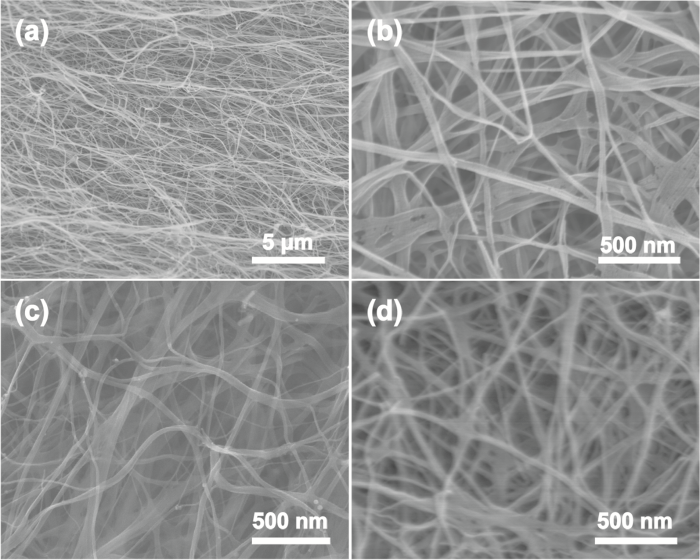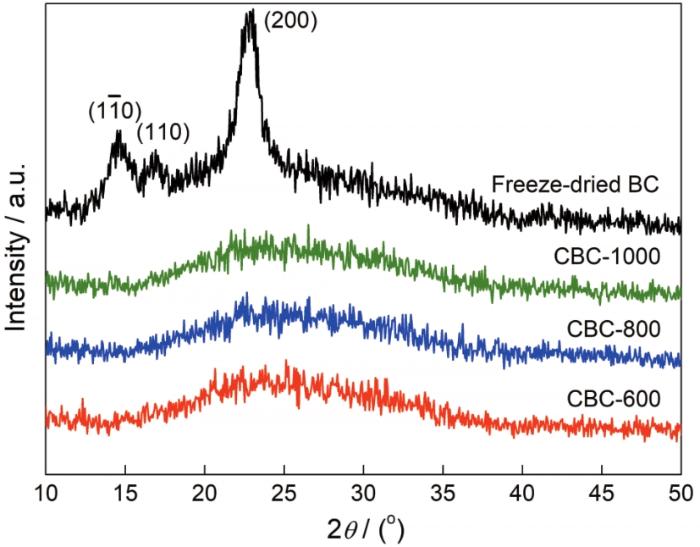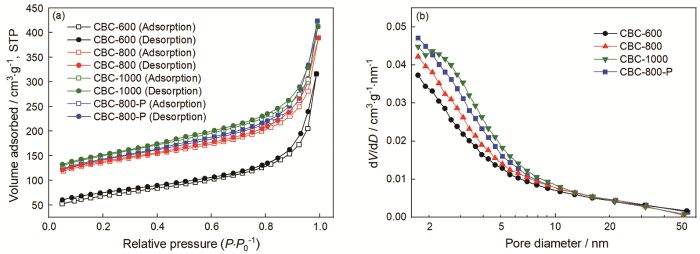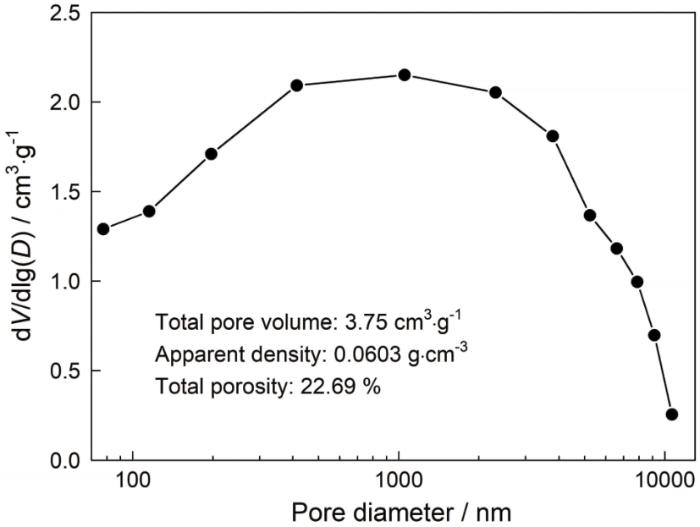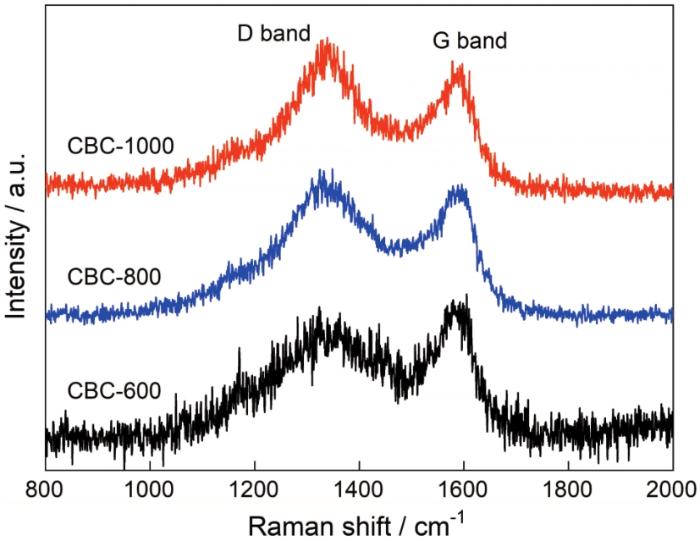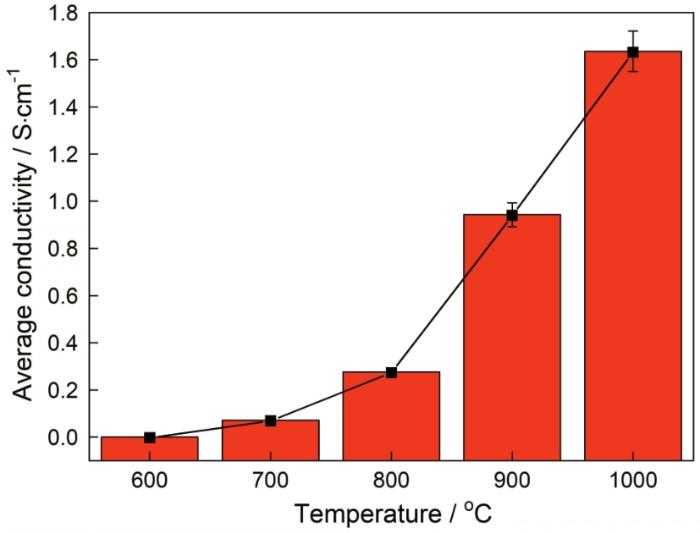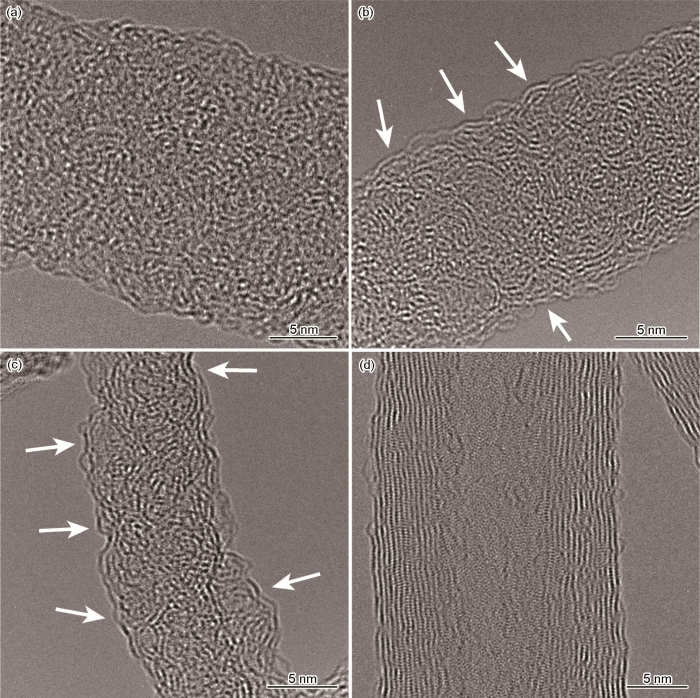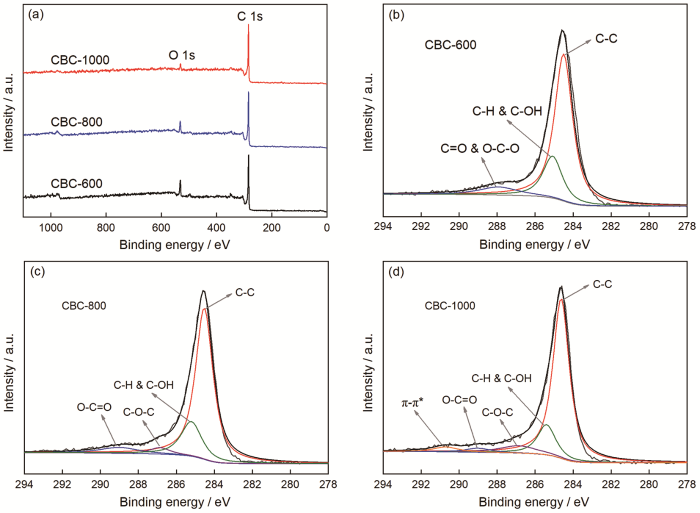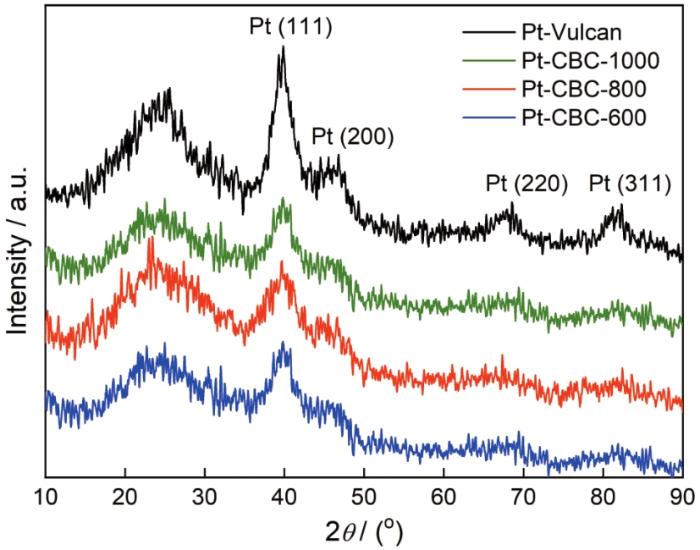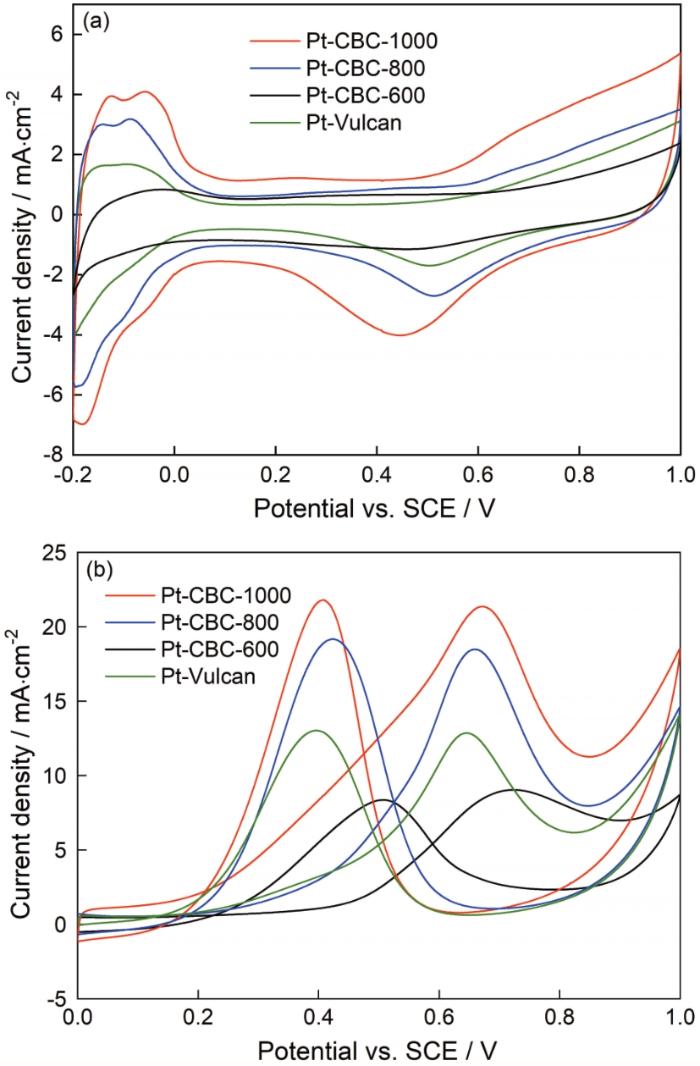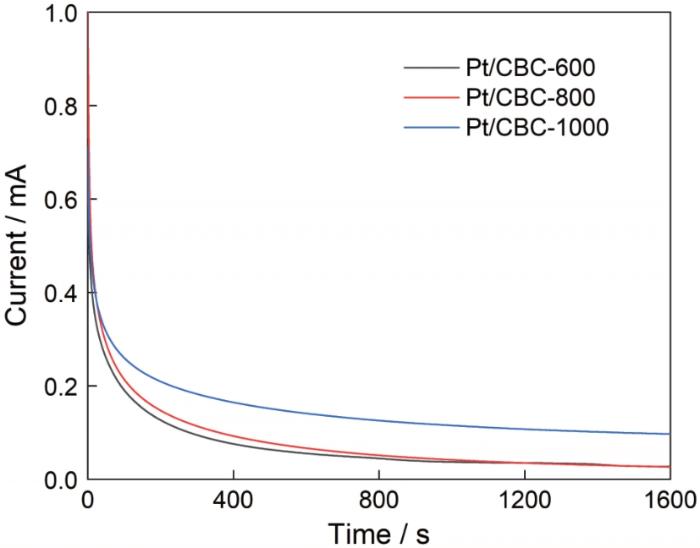近年来石油资源日渐枯竭,因此以生物质材料为前驱体制备的碳基材料即生物质碳材料受到了极大的关注。纤维素是地球上最丰富的天然生物质材料[1],细菌纤维素(Bacteria Cellulose,BC)是一种典型的生物质纳米纤维材料。与植物纤维素类似,BC的化学本质是由β-1,4-糖苷键所连接的多糖高分子聚合物,其分子链包含(C6H10O5)n基本单元结构。与植物纤维素对比,BC是一种纤维素成分含量极高(几乎100%)的生物质材料。BC不含半纤维素、木质素和果胶等杂质,因此不再需要提纯[2]。作为细菌的次生代谢产物,BC具有由细菌合成的纳米纤维(直径约70 nm)交错形成的高孔隙率三维(3D)体型结构。同时,BC具有高结晶度,因此其机械性能(杨氏模量可达138 GPa,抗拉强度可达2 GPa以上)[3]优良。总之,BC具有结晶度高、纤维超细、碳含量高以及3D结构连续等优点,有利于制备高性能生物质碳材料[4]。
碳化细菌纤维素(CBC)可以通过在惰性气体中高温碳化BC气凝胶大量生产。CBC可以继承BC前体的部分优点,如3D连续结构,互连的纤维网络和极高的孔隙率,并获得高电导率,高化学耐受性和超轻性。但是,过高的温度不仅会增加能耗,更不利于保持材料的宏观3D结构。即使在3000℃高温煅烧碳化细菌纤维素,也难以使其具有较高的机械强度[5],因此研究人员大多在低于1000℃的碳化温度下研究CBC的功能应用。目前关于CBC的研究主要集中在开发其应用性能[3],缺少对CBC本征属性的研究。本文系统研究在不同碳化温度下CBC碳纳米纤维的表观形态、微纳结构、化学组成、电子迁移能力等的变化和演化。在CBC碳纤维表面负载纳米Pt制备甲醇电催化剂复合材料,研究其电催化活性与理化性质的内在联系。
1 实验方法
1.1 CBC碳纳米纤维和Pt/CBC电催化剂的合成
1.1.1 CBC碳纳米纤维的制备
实验用BC,按照文献[6]的方法制备和纯化。将纯化后的水凝胶态BC经过液氮预降温后进行冷冻干燥,冷冻干燥机冷阱的温度低于-40℃,真空度小于10 Pa,冻干时间大于10 h。冷冻完成后得到气凝胶态的BC。
BC的碳化在管式马弗炉中进行。开始碳化前,预通氮气20 min并维持氮气流量为100 mL/min。开始碳化时,升温速率为2℃/min,达到目标温度(不同样品分别为600、800、1000℃)后保温1 h,降温速度为5℃/min。将得到的样品记为CBC-T,其中T代表碳化过程的目标温度。对BC进行压平处理(压力约为0.5 MPa)后再高温碳化以研究压平处理对碳纳米纤维的影响。目标碳化温度为800℃,将所得样品记为CBC-800-P。
1.1.2 Pt/CBC甲醇电催化剂的制备
用还原法制备CBC负载金属Pt催化剂。为了确定金属Pt在CBC碳纤维上负载量,进行以下实验。
将碳化后的CBC充分研磨至粉末状。取10 mg粉末加入40 mL乙二醇,进行充分的超声处理以保证其分散性,然后在搅拌条件下添加117 μL金属Pt浓度为0.015 g/mL的氯铂酸溶液。向上述溶液中加入1 mol/L NaOH溶液至溶液pH值为9.0,并持续搅拌30 min。将充分搅拌后的溶液移入圆底烧瓶,用油浴将其升温至75℃,然后缓慢加入2.5 mL浓度为37%的福尔马林。加入福尔马林后,将温度升高至90℃并维持3 h。温度降低后对所得材料进行离心洗涤,重复离心过程至液体pH接近7.0。将所得样品置于60℃真空烘箱中完全干燥后,获得Pt/CBC复合材料。将所得样品记为Pt-CBC-T,其中T为碳化过程的碳化温度。使用Vulcan XC-72R载体作为对照,用相同的方法负载纳米Pt颗粒,将所得对照样品记为Pt-Vulcan。
1.2 样品的表征
1.2.1 CBC碳纳米纤维的表征
用扫描电子显微镜(SEM)和透射电子显微镜(TEM)观测样品形貌和结构。将样品加入无水乙醇中,并超声形成分散液,然后将其滴在铜网上进行干燥,用于TEM观察。可将CBC材料粘至导电胶,因为BC气凝胶没有导电能力,故进行喷金处理用于SEM观测。对压平处理后的BC和碳化后的CBC材料进行SEM观测,并进行N2吸附/脱附测试。
使用热重分析(TGA)研究BC的热稳定性,升温范围为50~800℃,升温速率为10℃/min,气氛为氮气气氛。使用X射线光电子能谱(XPS)研究样品表面的元素种类和其价态,并分析元素C、O的结合方式和所含比例。拉曼光谱的光源为激发波长532 nm的Ar离子激光,测试范围为800 ~ 2000 cm-1。X射线衍射(XRD)实验使用Cu-Kα射线(λ=0.15418 nm),扫描速率为4°/min。在N2吸附/脱附实验中,用Barrett-Joyner-Halenda(BJH)方法测定孔尺寸分布和孔容,用Brunauer-Emmett-Teller(BET)方法计算比表面积。使用四探针法测试CBC材料的电导率,样品的厚度约为0.5 mm,对各碳化温度的样品测试10个点,计算结果的平均值和标准偏差。
1.2.2 测试Pt/CBC复合材料的甲醇电催化活性
使用电化学工作站(CHI 760D)在三电极体系下进行电化学测试,对电极为铂片,参比电极为饱和甘汞电极,工作电极为涂有催化剂材料的玻碳电极,其直径为3 mm。工作电极的制备:配制异丙醇的水溶液(异丙醇与水的体积比为1:3),于4.0 mL上述溶液中加入5.0 mg的催化剂材料和80 μL Nafion溶液,超声30 min以形成分散液。将20 μL上述分散液滴于玻碳电极表面,在室温下干燥。使用循环伏安法(CV)研究催化剂的电化学活性表面积(ECSA),进行甲醇电催化实验研究样品的催化性能,使用计时电流法比较催化剂样品的催化稳定性。使用0.5 mol/L H2SO4溶液(电解液)进行ECSA测试,扫描范围为-0.2~1.0 V, 扫描速率为50 mV/s。使用电解液为0.5 mol/L H2SO4+1.0 mol/L CH3OH的混合溶液进行甲醇电催化实验,扫描范围为0~1.0,扫描速率为50 mV/s。计时电流法使用的电解液为0.5 mol/L H2SO4+1.0 mol/L CH3OH,电位固定为0.65 V。
2 结果和讨论
2.1 CBC材料的基本理化性质
2.1.1 BC和CBC材料的微观形貌和纳米结构
图1
图1
冷冻干燥后的BC气凝胶,BC碳化所得CBC材料以及压平后BC碳化所得CBC材料的SEM照片
Fig.1
SEM images of (a, b) BC aerogels dried by freeze drying,(c) natural CBC aerogels and (d) pressed BC derived CBC aerogels
图2
图2
水凝胶态BC分散后、冷冻干燥BC碳化所得CBC以及用鼓风烘箱干燥并碳化的CBC的TEM照片
Fig.2
TEM images of (a) dispersed BC hydrogel, (b) freeze-dried BC derived CBC, (c, d) oven-dried BC derived CBC
2.1.2 CBC材料的TGA曲线
根据TGA曲线研究BC样品的热稳定性。在BC的TGA曲线中(图3),在100℃左右出现少量质量损失,可能源于水分的蒸发;在200~300℃出现了明显的质量损失,可能源于碳、氢、氧元素以CO、CO2、H2O等形式逸出,初步判断BC分子链结构在200~300℃开始破坏。
图3
2.1.3 CBC材料的XRD谱
图4
2.1.4 CBC材料的孔结构和比表面积
图5
图5
CBC样品的N2等温吸附/脱附曲线及其孔径分布
Fig.5
N2 isotherms adsorption/desorption curves (a) and pore size distributions of CBC samples (b)
表1 CBC样品的比表面积和孔道结构
Table 1
| Samples | Specific surface area /m2·g-1 | Average pore diameter /nm | Pore volume /cm3·g-1 | Micropore area /m2·g-1 |
|---|---|---|---|---|
| CBC-600 | 238.1 | 10.22 | 0.45 | 35.9 |
CBC-800 CBC-1000 | 443.3 490.5 | 9.48 8.54 | 0.47 0.50 | 216.5 225.5 |
| CBC-800-P | 463.6 | 9.38 | 0.53 | 207.9 |
材料中可能有N2吸附/脱附测试所不能精确检测到的大孔,因此用压汞法测试CBC-800-P的孔体积。压汞法的测量结果表明,材料的孔容为3.75 cm3/g,远高于N2吸附/脱附测试的结果(0.53 cm3/g)。计算图6面积的积分发现,孔径超过100 nm的孔可达总孔容的93%。测试结果表明,CBC-800-P有相当多的大孔,这与其形貌观察结果吻合。另外,压平后的样品其表观密度和孔隙率适中。
图6
2.1.5 CBC材料的芳构化和有序性
图7
表2 各种CBC样品的D峰半高宽和ID/IG
Table 2
| Samples | ID/IG | D band width/cm-1 |
|---|---|---|
| CBC-600 | 0.84 | 254.8 |
| CBC-800 | 1.07 | 203.9 |
| CBC-1000 | 1.18 | 155.2 |
2.1.6 CBC材料的电导率变化和结构分析
由图8可见,在600~1000℃碳化,温度升高使CBC材料的导电性能提高,其中CBC-1000的电导率比CBC-700提高了21倍。电导率提高的原因是,较高的碳化温度使材料的宏观体积变小而导电的碳纳米团簇变大,使导电碳纳米团簇更加接近甚至相互接触的概率增大,有利于电导率的提高。
图8
图8
在600~1000℃碳化所得CBC材料的电导性能
Fig.8
Electrical conductivity of CBC materials carbonized at 600~1000℃
以高分辨率TEM(HRTEM)观察BC的微观结构,根据微观结构的变化解释电导率的变化。对比图9中的各图可见,CBC-600材料基本上是一类无定型的碳材料。CBC-800逐渐出现沿着纤维轴向的、较连续的石墨晶格条纹(图9b中的箭头所示),而CBC-1000的石墨晶格条纹明显增加、增长并且弯曲(图9c箭头所示)。Rhim等[23]在纤维素碳化实验中发现了近似条纹,命名为“onion-like”结构。这种由sp2杂化碳构成的石墨结构,可提高材料的导电性能[24]。但是与图9d中石墨化程度很高的CNT对比,CBC样品的石墨结构还有明显的差距,因此仍可将其认定为无定型碳材料。表面机械应力大的材料,在碳化过程中其表面更倾向于形成石墨化结构。而BC的表面机械应力较大,且与植物纤维相比其纤维丝较小,较大的厚度也使其更容易形成高石墨化程度的碳材料[25, 26]。
图9
图9
在600、800 和1000℃碳化所得CBC样品和市售CNTs的HRTEM照片
Fig.9
HRTEM photographs of CBC samples carbonized at (a) 600℃, (b) 800℃ and (c) 1000℃ (with graphite structure marked) and (d) commercially available CNTs
2.1.7 CBC材料表面元素分析
图10
图10
在600~1000℃碳化后CBC材料的XPS全谱和C 1s分峰图
Fig.10
(a) Wide XPS spectra of CBC materials carbonized at 600~1000℃ and C 1s splitting peak diagram of CBC materials carbonized at (b) 600℃, (c) 800℃, (d) 1000℃
表3 在600~1000℃碳化所得CBC材料的O/C原子比值以及各峰的结合能(括号内为各峰和C-C峰的面积之比)
Table 3
| Samples | O/C ratios | C-C | C=O & O-C-O | C-H & C-OH | O-C=O | C-O-C |
|---|---|---|---|---|---|---|
| CBC-600 | 0.15 | 284.5 (100) | 287.9 (11.9) | 285.1 (30.5) | - | - |
| CBC-800 | 0.10 | 284.5 (100) | - | 285.2 (26.9) | 289.0 (8.5) | 286.8 (4.9) |
| CBC-1000 | 0.05 | 284.6 (100) | - | 285.4 (20.6) | 289.0 (3.8) | 286.8 (10.2) |
使用软件中的Lorentzian-Gaussian项对各种CBC材料的C 1s窄谱分峰,发现其中的主要峰分别为聚芳香碳(C-C)、脂肪碳和羟基碳(C-H & C-OH)、单个氧原子相连的两个碳(C-O-C)、和氧以双键相连或和两个氧以单键相连的碳(C=O & O-C-O)、羧基碳(O-C=O)和π-π*震动峰[17, 23, 29]。观察图10b~d中各CBC材料的C 1s谱图发现,C-C峰是最强的峰。此外,C-H & C-OH峰有一定的强度,但是随着温度的上升强度呈减弱趋势(表3)。可以推测,较高的温度会破坏脂肪碳链的原有交联关系,使材料的结构组成更倾向于有序排布的聚芳香碳[30]。从表3可见,在高温下O-C-O与O-C=O等较不稳定的含氧结构其比例降低,更加稳定的C-O-C峰则变强,验证了残留氧原子的高稳定性,且更直接确认了在实验温度范围内O/C原子比值与温度的上升成反比。在图10d的CBC-1000的谱图中291 eV附近发现π-π*震动峰,表明形成了较多的稠环碳。这会产生π电子离域系统从而提高π电子数量,使电导率明显提高[31]。
2.2 CBC材料的甲醇电催化应用
图11
图11
Pt-CBC-800和Pt-Vulcan的TEM照片以及Gatan Digital Micrograph软件测出的晶格间距
Fig.11
TEM images of Pt-CBC-800 at different magnifications (a, b, d) and Pt-Vulcan (c), and the lattice spacing measured by Gatan Digital Micrograph software (e)
图12
图12
Pt-CBC复合材料和Pt-Vulcan的XRD谱
Fig.12
XRD patterns of Pt-CBC composites and Pt-Vulcan
图13
图13
Pt-CBC复合材料和Pt-Vulcan在0.5 mol/L H2SO4以及0.5 mol/L H2SO4+1.0 mol/L CH3OH溶液中的CV曲线
Fig.13
CV curves of Pt-CBC composite and Pt-Vulcan in (a) 0.5 mol/L H2SO4 and (b) 0.5 mol/L H2SO4+1.0 mol/L CH3OH solution
表4 各种催化材料样品的CV数据
Table 4
| Samples | ECSA /m2·g-1 | IR /mA·cm-2 | IF /mA·cm-2 | Onset potential/mV |
|---|---|---|---|---|
| Pt-CBC-600 | 5.5 | 8.3 | 9.0 | 415 |
| Pt-CBC-800 | 53.8 | 19.1 | 18.5 | 395 |
| Pt-CBC-1000 | 65.2 | 21.7 | 21.4 | 234 |
| Pt-Vulcan | 32.9 | 12.9 | 12.8 | 259 |
图14
图14
Pt-CBC样品在0.5 mol/L H2SO4+1.0 mol/L CH3OH混合溶液中的计时电流曲线
Fig.14
Chronoamperometric curves of Pt-CBC samples in 0.5 mol/L H2SO4+1.0 mol/L CH3OH
3 结论
(1) 与烘箱干燥相比,冷冻干燥CBC更好。冷冻干燥的BC碳化后其3D纤维网络形态能完好地保留。对BC气凝胶进行压平处理,得到的结构更适用于电化学储能。
(2) CBC是一类无定型碳,其比表面积大、孔道丰富,小孔数量多。CBC的孔容比N2吸附/脱附测试结果更大,因为CBC材料有纳米纤维交织产生的大孔。CBC中有部分石墨晶体,随着碳化温度的提高其含量提高、尺寸增大。
(3) 将纳米Pt颗粒负载于CBC碳纤维表面,可用作甲醇氧化的电催化剂。CBC作为阳极催化剂载体,其比表面积大、孔道结构丰富并有氧元素残余。与对照样品Vulcan XC-72R相比,CBC碳载体中的纳米Pt微粒分布均匀,粒径更小,电催化活性更高。
参考文献
Composites from renewable and sustainable resources: Challenges and innovations
[J].
Recent advances in bacterial cellulose
[J].
Bacterial cellulose: A robust platform for design of three dimensional carbon-based functional nanomaterials
[J].
Bacterial cellulose nanocomposites: An all-nano type of material
[J].
Acceleration of graphitization on carbon nanofibers prepared from bacteria cellulose dispersed in ethanol
[J].
In situ deposition of platinum nanoparticles on bacterial cellulose membranes and evaluation of PEM fuel cell performance
[J].
Ultrastructural development of the softwood cell wall during pyrolysis
[J].
Microstructural evolution during charcoal carbonization by X-ray diffraction analysis
[J].
Effects of different drying processes on physical properties of bacterial cellulose membranes
[J].
不同干燥方式对细菌纤维素物理性能的影响
[J].
Overview on native cellulose and microcrystalline cellulose I structure studied by X-ray diffraction (WAXD): Comparison between measurement techniques
[J].
Investigation into the structural, morphological, mechanical and thermal behaviour of bacterial cellulose after a two-step purification process
[J].
Graphitization of highly crystalline cellulose
[J].
Graphitic carbon nanostructures from cellulose
[J].
Electrochemical properties of PAN-based carbon fibers as anodes for rechargeable lithium ion batteries
[J].
Molybdenum oxide/carbon composite electrodes as electrochemical supercapacitors
[J].
Ultra-thin carbon nanofiber networks derived from bacterial cellulose for capacitive deionization
[J].
Spectroscopic analysis of carbonization behavior of wood, cellulose and lignin
[J].
Decomposition and carbonisation of wood biopolymers—a microstructural study of softwood pyrolysis
[J].
Raman microprobe studies on carbon materials
[J].
Chemical analysis of graphene oxide films after heat and chemical treatments by X-ray photoelectron and Micro-Raman spectroscopy
[J].
Raman spectroscopy of graphene and graphite: Disorder, electron-phonon coupling, doping and nonadiabatic effects
[J].
Interpretation of Raman spectra of disordered and amorphous carbon
[J].
Changes in electrical and microstructural properties of microcrystalline cellulose as function of carbonization temperature
[J].
Changes in the thermophysical properties of microcrystalline cellulose as function of carbonization temperature
[J].
Acceleration of graphitization on carbon nanofibers prepared from bacteria cellulose dispersed in ethanol
[J].
Carbon fibres from cellulosic precursors: a review
[J].
Three-dimensional heteroatom-doped carbon nanofiber networks derived from bacterial cellulose for supercapacitors
[J].
Porous carbon nanofiber webs derived from bacterial cellulose as an anode for high performance lithium ion batteries
[J].
Characterization of wood chars produced at different temperatures using advanced solid-state 13C NMR spectroscopic techniques
[J].
Surface characterization of electrochemically oxidized carbon fibers
[J].
Effect of reduction-oxidation treatment on the catalytic activity over tin oxide supported platinum catalysts
[J].
A review of anode catalysis in the direct methanol fuel cell
[J].
Graphene-supported nanoelectrocatalysts for fuel cells: Synthesis, properties, and applications
[J].
Simple preparation of carbonized bacterial cellulose–Pt composite as a high performance electrocatalyst for direct methanol fuel cells (DMFC)
[J].
Platinum nanoparticles supported on activated carbon fiber as catalyst for methanol oxidation
[J].
Preparation and electrochemical performance for methanol oxidation of pt/graphene nanocomposites
[J].
Effects of particle proximity and composition of Pt-M (M=Mn, Fe, Co) nanoparticles on electrocatalysis in methanol oxidation reaction
[J].
Paper-structured fiber composites impregnated with platinum nanoparticles synthesized on a carbon fiber matrix for catalytic reduction of nitrogen oxides
[J].
Nano-stuctured Pt–Fe/C as cathode catalyst in direct methanol fuel cell
[J].
Rapid microwave synthesis of CO tolerant reduced graphene oxide-supported platinum electrocatalysts for oxidation of methanol
[J].
Comparison of high surface Pt/C catalysts by cyclic voltammetry
[J].
Catalytic performance of Pt nanoparticles on reduced graphene oxide for methanol electro-oxidation
[J].
Facile synthesis of poly(amidoamine)-modified carbon nanospheres supported Pt nanoparticles for direct methanol fuel cells
[J].




